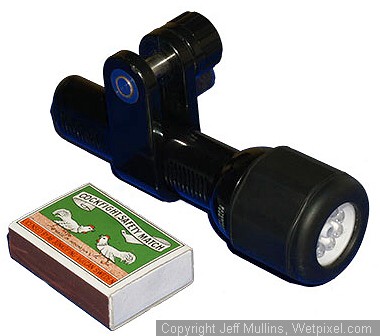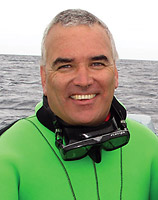10Bar Ultra Compact Focusing Light Review
Although I have found that even in dull conditions most digital cameras I use underwater have very good auto-focus. There have been odd times when a small focusing light would aid the camera in being able to focus-lock much faster. I notice this most when diving around caves, shaded ledges and wrecks. Where there’s very low ambient light, the camera’s auto focus system hunts for focus-lock.
Now I have seen some ‘monster’ lights being used by underwater photographers, some are as big (or bigger) as the camera housing itself! I own an Underwater Kinetics HID Light Cannon 100, which is fantastic night diving light. So not being one to waste money on un-necessary u/w camera equipment (at least when the wife is watching anyway). I figured that the Light Cannon should make a great focusing light - particularly since I already owned one!
My conclusion was pretty easy to report….. Sadly it is far too bright and too big (and clumsy) for use as a focusing light (which it was never designed to be). The biggest problem is its brightness! Even with the diffuser fitted this light showed hot spots in the final image, and I am sure I saw one particular nudibranch squinting when I got a bit too close; also every fish in-sight disappeared as soon as I turned the light on!
The main reason for even thinking about using a focusing light was a tiny boxer crab that lives at one of my regular dive haunts. I had seen that it was carrying eggs that were clearly visible under its abdomen, and I of course wanted a photo of the crab showing its eggs.
This particular crab resides on a black sand slope among small black pebbles, at a depth of around 12 metres. This alone wouldn’t be a problem, but since this crab began carrying eggs, it would only venture from its refuge among the pebbles at sunset. I figured this was to avoid fishy predators that during broad daylight, would probably regard an egg-laden crab as lunch.
I had tried unsuccessfully without a focusing light - to capture the boxer crab and its future offspring. Light conditions were so low that my Olympus E-330 DSLR was struggling. Around eight out ten shots I took were not in focus - and fairly typically the two shots that were focused, weren’t composed well. The dull lighting combined with the lack of contrast in the crab’s body was making it very difficult for the camera’s auto focus to lock onto the crab. I needed an answer - a fast answer. Otherwise my crab friend was very soon going to be egg-less and I…would be photo-less.
The answer to my dilemma came in an e-mail newsletter from Hong Kong based u/w camera gear distributor 10Bar. Their newsletter had an LED Ultra Compact Focusing Light with Auto Cut-Out, for what I thought at first was a printing error. A price I boldly advised my wife would make an ideal early birthday present at only US$45. The most interesting feature of this light was its Auto Cut-Out feature. The newsletter indicated that the light would turn off when it sensed the camera strobe firing, so the light would not appear in the image as a hotspot on the subject.

A week later my early birthday present (11 months early) arrived by mail, and I had to admit I was a little disappointed…it was so small. How could I show off my new light, if I could hardly see it? I quickly slipped in four AAA batteries and turned it on. Well it certainly threw out plenty of light, in a nice bluish/white colour with quite a soft, even beam. It also came complete with a mounting bracket that can be connected to Sea & Sea type strobe arms (YS mount). Well…size aside, it seemed like it might do the job.
Without delay, I prepared my camera to head off in pursuit of my friend, the pregnant crab. First I figured I should try the light on a still subject before scaring the crab back into its rocky refuge. I soon found a nudibranch at around 28 metres deep under a dark ledge, a perfect test, as there was very little ambient light to aid focus. With the Ultra Compact LED Light aimed, I moved-in and watched the camera LCD screen as the Nudibranch appeared bright lit-up and sharp.

The camera focused almost instantly and after releasing the shutter, the strobes fired, the light switched-off and the image appeared on the camera LCD. A second later the light switched back-on. I checked the image on the camera LCD screen for any evidence of the light showing-up in the image, but it showed only the strobe exposure (as it should). Now it was time to locate the boxer crab and wait for it to come out and play.
I surprised myself by easily finding the crab. The small white anemones that this species carry in their pincers, soon gives away their hiding spot under the side of a pebble. Ten minutes later the tiny crab emerged from its refuge and wandered down the slope straight towards me. I left the light aimed where it had been on my previous nudibranch photo, and moved in ever so slowly. The crab came into view and filled the frame - it didn’t appear to be disturbed at all by the light. The camera focused very quickly and I took my shot. Wow, the eggs were clearly visible and all nice and sharp. I tried only four shots and each was pin sharp…....Happy (early) Birthday Jeff!

This tiny Boxer Crab carrying eggs was my excuse for
purchasing the 10Bar Ultra Compact LED Focusing Light.
Olympus E330, 10Bar Housing, 50mm Olympus Zuiko F2.0 Macro, ‘Reefnet’ external close-up lens,
ISO 100 F22@1/160th, 2x Inon Z220 strobes, manual exposure
Ultra Compact LED Light Specifications (as tested)
- Powered by four AAA batteries (Alkaline/Ni-Cad/Ni-Mh).
- Battery Life: Minimum 12 hours on cheap alkaline batteries - greater with Ni-Mh high current batteries.
- Size: Length - 130mm (5”)
- Width - Head 38mm (1½”) + Body 26mm (1”)
- On/Off switch - Twist Head
- Globe - 8x LED cluster, soft/diffused blue light
- Auto-Off circuitry built-in. (Light turns off automatically when strobe fires, then re-lights after approximately 1½ seconds)
- Mounting - Comes with Sea & Sea YS Strobe style bracket (removable)
- Waterproof - to 100 metres depth (330’)
- Practical Use - Low light macro focusing, night dive focusing
- Price - US$45
- Sales Contact - .(JavaScript must be enabled to view this email address)
-Jeff Mullins
www.reefwreckandcritter.com
Author Bio:

Jeff Mullins has been exploring under the seas of Australia, South-East Asia & the South Pacific for 36 years. He began taking underwater photographs in 1976 and has since been published Worldwide. Jeff was awarded the PADI Hallmark of Excellence Award for Outstanding Contribution to Photo Journalism in 1995.
Currently Jeff runs one on one Digital Underwater Photography Courses in Tulamben, Bali - specialising in small groups of divers with an interest in underwater photography and marine life. Visit his website at reefwreckandcritter.com. Jeff & his wife Dawn have recently published a book titled Reef Wreck & Critter - Tulamben, a pictorial guide to Tulamben’s dive sites and marine life.